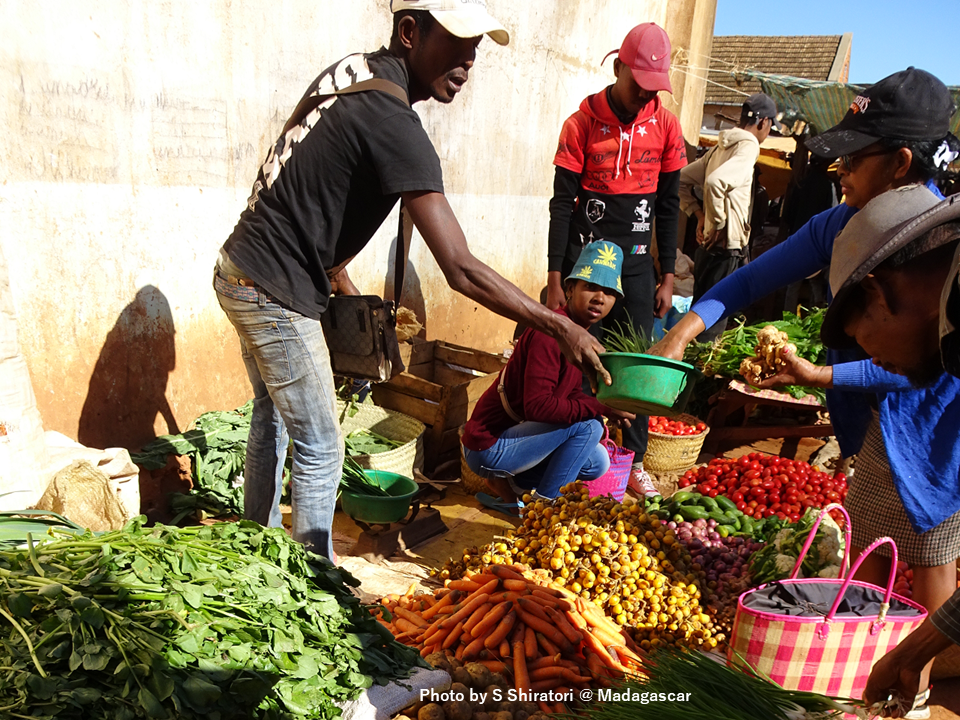Pick Up
713. Impact of Increased Productivity of Staple Crops on Improving Nutrition of Farmers

Sub-Saharan Africa has the highest rate of hunger in the world, which is attributed to extremely low crop productivity. Improved crop productivity is expected to increase the calorie and income sources for farmers, but the production and consumption of staple food crops alone does not provide sufficient micronutrients such as vitamin A. There is a need for research that quantitatively demonstrates how increased productivity of staple food crops leads to improved nutrition for farmers, including micronutrients.
Here, we introduce a research output from JIRCAS, which revealed that increasing the productivity of rice, a staple food in Madagascar, is effective in improving farmers' nutrition not only in terms of calories but also in the supply of micronutrients, such as vitamin A, in other words, in both quantity and quality, through changes in farmers' consumption and purchasing behavior.
Madagascar is a major rice-producing country, where per capita rice consumption is more than twice that of Japan and more than half of the population is engaged in rice cultivation. At the same time, 1 in 2 people in the country suffers from serious problems such as malnutrition. To evaluate the impact of agricultural production on farm household income and nutrition, a joint research of JIRCAS, the University of Tokyo, and the National Office of Nutrition of Madagascar monitored production and consumption of 600 households in the Vakinankaratra region of rural Madagascar, and analyzed the results using econometric methods.
The results showed that an increase in rice yield also increased the supply of calories, zinc, iron, and vitamin A, which are in short supply in the target area. In addition, the improvement in rice yield increased not only rice consumption but also cash income from selling rice. The increase in cash income has led to increased purchases of vegetables, fruits, meat and fish at the market. Furthermore, the proximity of households to major roads (good market access) facilitated increase in rice sales, suggesting the importance of the role played by the market.
In this study, it has been clarified that increased rice productivity not only increases consumption, but also improves farmers' nutrition in terms of both quality and quantity through the purchase of nutritious foods through the market channel. Furthermore, JIRCAS has realized the development of efficient fertilization technology and new rice varieties to improve rice production in Madagascar. These technological interventions that contribute to improving paddy rice productivity are expected to result in diversification of purchasing behavior through consumption and markets, which will improve nutrition of poor farmers and eventually contribute to SDG Goal 2 "Zero Hunger".
References
Nikiema, R.A., Shiratori, S., Rafalimanantsoa, J., Ozaki, R., and Sakurai, T. How are higher rice yields associated with dietary outcomes of smallholder farm households of Madagascar?. Food Security. (2023). https://doi.org/10.1007/s12571-022-01333-5
Increased Rice Yield Improves Nutrition of Farmers in Madagascar―Towards solving malnutrition problem in Africa by improving productivity of staple crops―
https://www.jircas.go.jp/en/release/2022/press202219
New Rice Varieties Released in Madagascar― FyVary varieties show high productivity under nutrient deficiencies―
https://www.jircas.go.jp/en/release/2021/press202117
Phosphorus dipping treatment of rice seedlings increases yield and avoids cold damage ―Towards stable rice production in Africa with minimal fertilizer input―
https://www.jircas.go.jp/en/release/2020/press202001
Contributors: SHIRATORI Sakiko (Information and Public Relations Office), OZAKI Ryosuke (Social Sciences Division), TSUJIMOTO Yasuhiro (Crop, Livestock and Environment Division)
